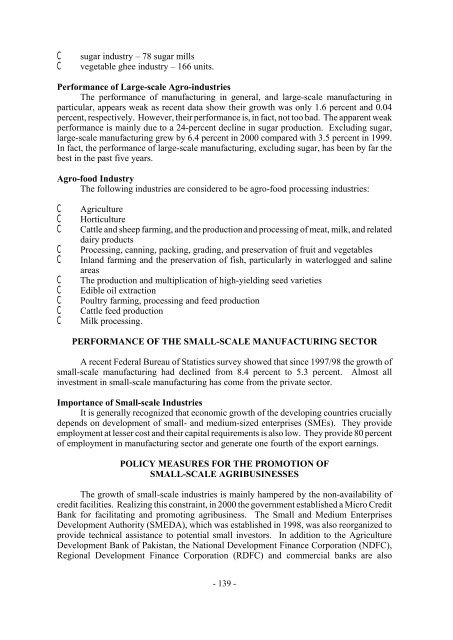Development of Agribusiness Enterprises - Asian Productivity ...
Development of Agribusiness Enterprises - Asian Productivity ...
Development of Agribusiness Enterprises - Asian Productivity ...
Create successful ePaper yourself
Turn your PDF publications into a flip-book with our unique Google optimized e-Paper software.
C sugar industry – 78 sugar mills<br />
C vegetable ghee industry – 166 units.<br />
Performance <strong>of</strong> Large-scale Agro-industries<br />
The performance <strong>of</strong> manufacturing in general, and large-scale manufacturing in<br />
particular, appears weak as recent data show their growth was only 1.6 percent and 0.04<br />
percent, respectively. However, their performance is, in fact, not too bad. The apparent weak<br />
performance is mainly due to a 24-percent decline in sugar production. Excluding sugar,<br />
large-scale manufacturing grew by 6.4 percent in 2000 compared with 3.5 percent in 1999.<br />
In fact, the performance <strong>of</strong> large-scale manufacturing, excluding sugar, has been by far the<br />
best in the past five years.<br />
Agro-food Industry<br />
The following industries are considered to be agro-food processing industries:<br />
C Agriculture<br />
C Horticulture<br />
C Cattle and sheep farming, and the production and processing <strong>of</strong> meat, milk, and related<br />
dairy products<br />
C Processing, canning, packing, grading, and preservation <strong>of</strong> fruit and vegetables<br />
C Inland farming and the preservation <strong>of</strong> fish, particularly in waterlogged and saline<br />
areas<br />
C The production and multiplication <strong>of</strong> high-yielding seed varieties<br />
C Edible oil extraction<br />
C Poultry farming, processing and feed production<br />
C Cattle feed production<br />
C Milk processing.<br />
PERFORMANCE OF THE SMALL-SCALE MANUFACTURING SECTOR<br />
A recent Federal Bureau <strong>of</strong> Statistics survey showed that since 1997/98 the growth <strong>of</strong><br />
small-scale manufacturing had declined from 8.4 percent to 5.3 percent. Almost all<br />
investment in small-scale manufacturing has come from the private sector.<br />
Importance <strong>of</strong> Small-scale Industries<br />
It is generally recognized that economic growth <strong>of</strong> the developing countries crucially<br />
depends on development <strong>of</strong> small- and medium-sized enterprises (SMEs). They provide<br />
employment at lesser cost and their capital requirements is also low. They provide 80 percent<br />
<strong>of</strong> employment in manufacturing sector and generate one fourth <strong>of</strong> the export earnings.<br />
POLICY MEASURES FOR THE PROMOTION OF<br />
SMALL-SCALE AGRIBUSINESSES<br />
The growth <strong>of</strong> small-scale industries is mainly hampered by the non-availability <strong>of</strong><br />
credit facilities. Realizing this constraint, in 2000 the government established a Micro Credit<br />
Bank for facilitating and promoting agribusiness. The Small and Medium <strong>Enterprises</strong><br />
<strong>Development</strong> Authority (SMEDA), which was established in 1998, was also reorganized to<br />
provide technical assistance to potential small investors. In addition to the Agriculture<br />
<strong>Development</strong> Bank <strong>of</strong> Pakistan, the National <strong>Development</strong> Finance Corporation (NDFC),<br />
Regional <strong>Development</strong> Finance Corporation (RDFC) and commercial banks are also<br />
- 139 -
















